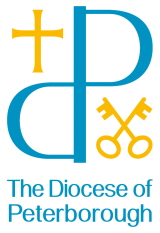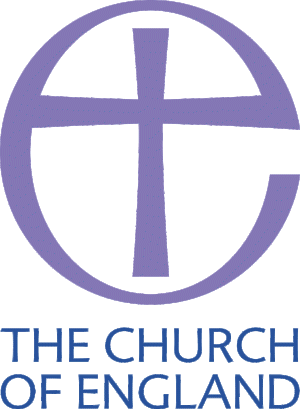Church History & Guide
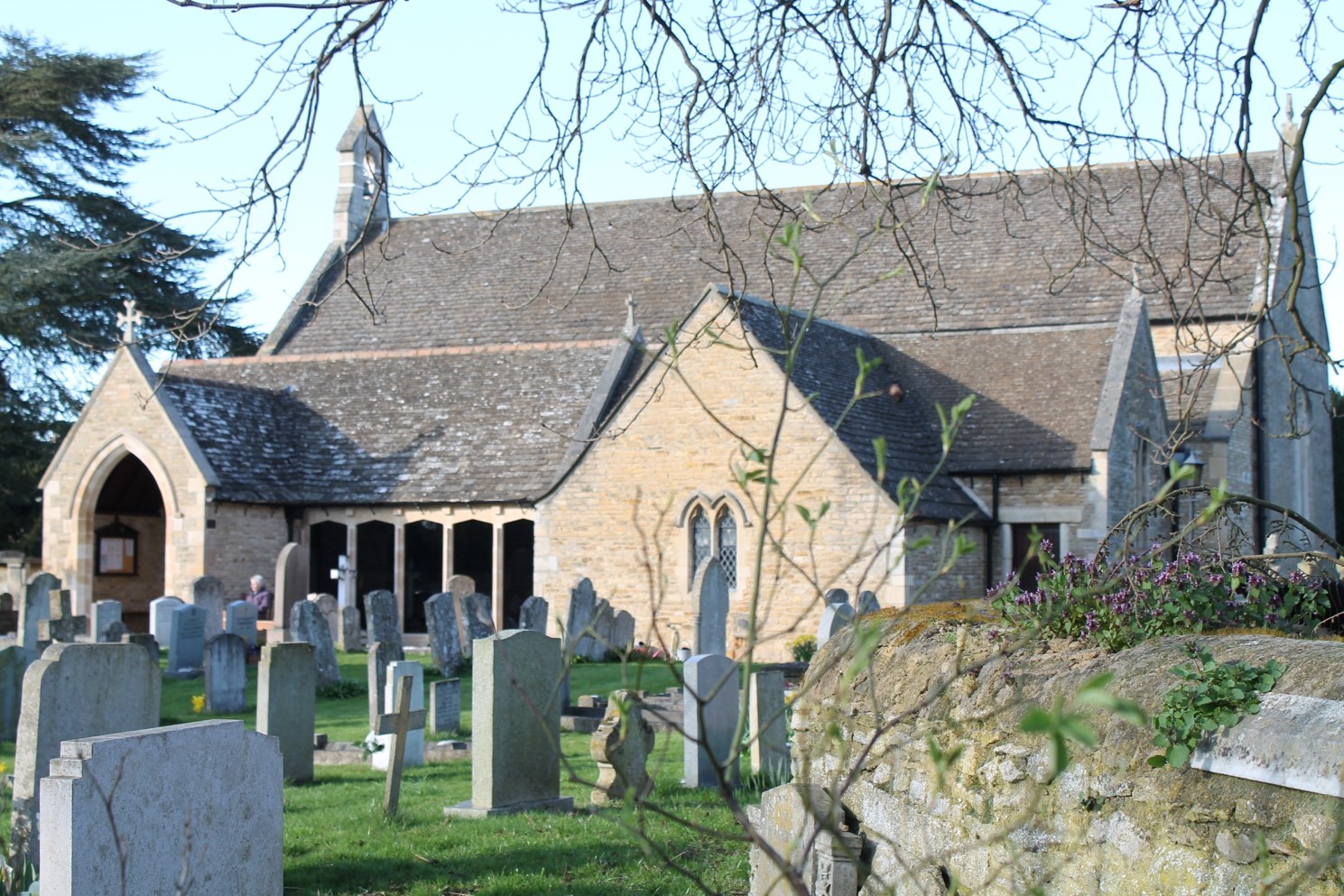
Welcome to our beautiful little church, named after St Botolph*, the 7th century patron saint of wayfarers who founded many churches in the East of England.
The present church on this site was built in 1263 in the Early English style. This was at the request and expense of Sir William de Thorpe, whose family later built Longthorpe Tower. At first a chapel in the parish of St John, it was consecrated as a church in 1850.
The church has been well used and much loved for over 750 years. It is noted for its stone, brass and stained-glass memorials to men killed in World War One, to members of the St John and Strong families of Thorpe Hall and to faithful members of the congregation.
Below you will find:
A. A walk round tour with a plan and descriptions of items in the nave and chancel (* means there is more about this person or place in the second half of this history.) The nave and chancel have been divided into twelve sections corresponding to the numbers on the map.
- The Font
- The Organ area; the West Window
- The North Door
- The North Aisle; the Epiphany Window
- The Horrell Window
- The Rood, the Chancel, North Side
- The Sanctuary Area; the Ascension Window
- The Altar Rail; the Reredos
- The Chancel, South Side; the Gaskell Brass Plaques
- The Lady Altar; the Annunciation Window
- Memorials to the Thorpe Hall families
- The Song of Solomon Window; the Roll of Honour
B. The history of St Botolph, this church and families connected to it
- St Botolph
- The de Thorpe Family, the church and Longthorpe Tower
- History of the church
- The Thorpe Hall connection: the St Johns and Strongs
- Father O'Reilly and the Oxford Movement
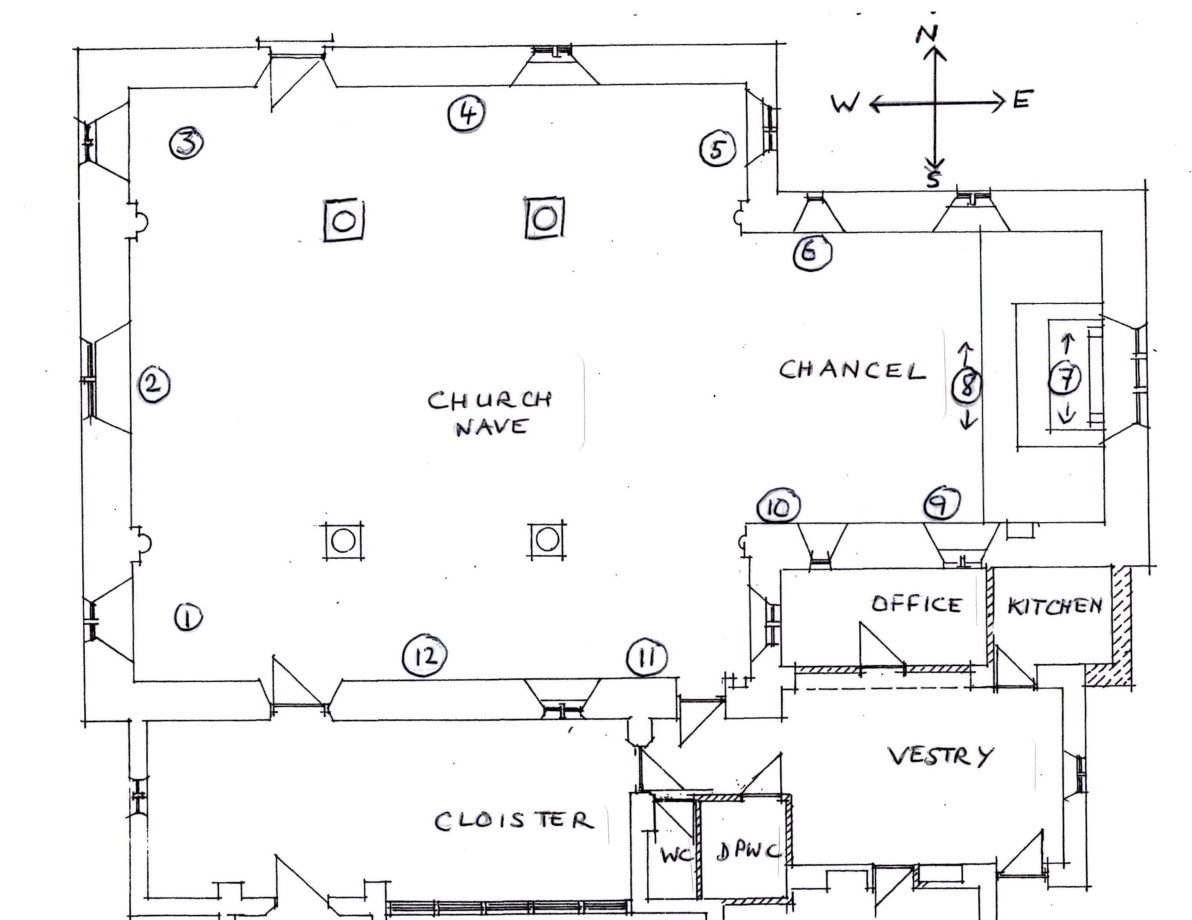
A. A WALK ROUND THE CHURCH
This guide takes you round the church in a clockwise direction. Enter by the south door in the cloister and turn to the left by the font to begin. The numbers on the plan refer to the sections of the description
1. The Font
The font is late 19th or early 20th century. An ancient font was found on the old Thorpe Avenue site and no one knows why it wasn’t moved here in 1263. It is now in St Jude’s church, Westwood, a church established with the help of the Revd Gibbings in the 1960s. It was originally by the northwest door, was moved to just east of the south door in 1978 then to its present where it was set in Purbeck stone in the 2021 Reordering Project.
Artist Arthur Beal who gave the church a copy of Holman Hunt’s painting “The Light of the World” was related to Denzil Day, organist for 50 years. Denzil came to Peterborough as an 8 year old orphan and was looked after by the O’Reilly household. Father O’Reilly taught him how to play the organ and was well rewarded, as you can see from the plaque paying tribute to him.
2. The organ area; the West Window
Look up to the west end and notice there are two windows high up. There used to be two bells here, above the old roof level. The present bell-cote is part of the 1869 restoration. Unfortunately, it was built too small for the original bell, so a modern one had to be put in. The old one, recorded as cracked in 1552, had been recast. It was sold at this point to a scrap-merchant, rescued and given to the Roman Catholic Church in Peterborough, where it still hangs, though during a service on 13th February 1892 the clapper fell out and crashed through a roof while the bell was being rung for morning service.
The window behind the organ was restored in 1938 in memory of the translation of the church to its present site by Sir William de Thorpe in 1263. It is the only trace of the family in the church. As employees of the abbey most of the family who lived in Longthorpe are buried in the cathedral grounds.
The plaque on the wall below the window is dedicated to John Roddis, clerk and sexton for 35 years. The village bootmaker, he is one of the many examples in this church of people who have served the church faithfully for years.
The organ, a baroque style pipe organ with two manuals and pedal board, was installed in 1974 by Gilks of Stanground, and at the same time the old organ in the north-eastern corner was demolished. The organ was refurbished in 2021.
On the organ pipes box are the previously mentioned plaques to Denzil Day and a second, in memory of Thomas Oliver. Thomas cycled from Park Road Peterborough twice every Sunday in all weathers and despite having an iron on one leg, to play here.
3. The North Door
The north door is used only for funerals nowadays. A board with the history and list of incumbents was dedicated in 1960 in memory of Mr and Mrs Ray Horrell, members of a farming family still active in the local community and was formerly by this door. The board is currently in storage, but it is planned to mount it on the west wall. The previous incumbents include the Revd Arthur James Skrimshire who was also chaplain of Peterborough Gaol. He additionally found time to develop a lavender and peppermint distillery close to the Holywell Grotto, using the spring water. His son, the Revd Arthur Charles combined his duties here with teaching at the King’s School. The Revd Holmes was also chaplain of the workhouse in Thorpe Road which was on the site of what is now the City Care Centre. You will see memorial plaques to The Revd Gaskell and two of his sons who died in WW1 later in the tour. The Revd Gibbings was a metallurgical engineer and chaplain to the Air Training Corps at nearby Westwood Airfield.
4. The North Aisle; The Epiphany Window
Here you see the first memorial on the tour to the Strong family of Thorpe Hall. John Isham Strong was the great-grandson of Revd William Strong. Next to the plaque is the first of the five stained glass windows in the church. These were made by A L Moore who with his son worked out of their London workshop to produce 1000 windows for all parts of the UK and 100 overseas. This window, the Epiphany, was paid for by the Maxwells in 1921 (at a cost of £61.10s). William George Maxwell, 1849-1929, was a dairy farmer at Longthorpe’s Manor Farm and he was churchwarden before and during the O’Reilly years. You will notice his name or initials in several places.5. The Horrell window
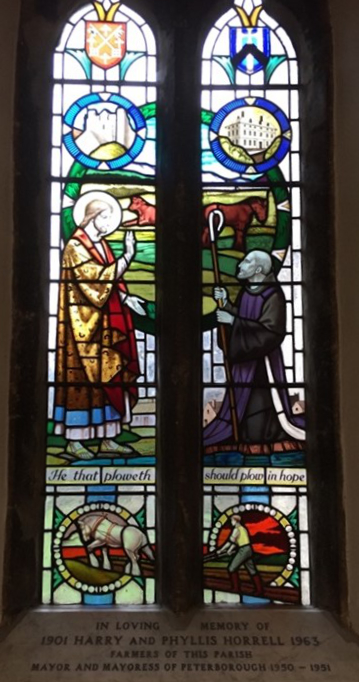
This window is more recent, having been made by Francis Skeat and installed in 1990 in memory of Harry and Phyllis Horrell, more members of the local farming family. It depicts a farming scene in Longthorpe, with the ploughing scene at the bottom and cow and horse in the middle behind Christ and the shepherd. The Horrells kept sheep in Milton Park, and had two herds of cows, Friesians and Guernseys, which grazed in Thorpe Park. You can see Longthorpe Tower and Thorpe Hall depicted above and at the very top the shield of Peterborough Diocese and one of the versions of the shield of St Botolph.
6. The Rood; the Chancel; North Side
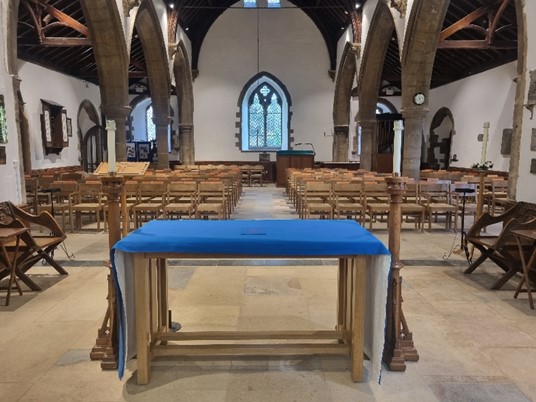
The new altar in position and the new chairs
John Leslie Shipsides, whose plaque is beneath William Slaughter’s, was also in the army, though this is not recorded on his plaque. His father was a gardener. John was in the Oxfordshire and Bucks Light Infantry and his regiment was stationed in Wiesbaden from 1926-1928 as part of the British Army on the Rhine (BAOR). So far, we have not found out how he died.
The plaque to PO Frank Giles is the only WW2 memorial in the church, though there is a stone to Corporal Denis Urwin of the Glider Pilot Regt, killed on active service in 1943, in the front section of the churchyard. 72 men and women from this area returned safely from the war and 6 were killed. The Longthorpe Village Hall, originally called the Memorial Hall, was built to commemorate those who fought in WW2.
Before the plaque from Father O’Reilly in memory of his mother you come to a low side window. There is another one on the south side of the chancel. Most experts believe that these were originally used in pre-Protestant times as confessionals, so that penitents could absolve their sins before coming into church. Another possibility is that they were windows to which lepers could come for communion.
7. The Sanctuary Area; the Ascension Window>
Look to the left and you see a door in the wood panelling. This conceals an aumbry in which the reserved sacrament of the bread and wine which has been blessed is kept for home communion. There is another aumbry on the opposite side of the sanctuary which is no longer used. These were inserted in 1320 along with piscinas, where the communion vessels were washed. Nowadays they are washed and dried in the sacristy. The white lights indicating that the reserved, consecrated sacrament is available are above the main altar and are on day and night when there is reserved sacrament available. The blue light above the Lady Altar indicates it is a Marian shrine.
The East window behind the altar is another A L Moore window. This one, depicting the Ascension, was installed in 1907 and restored in 2003 as the nearby plaques explain.
Note the Mothers’ Union banner. Our church branch of the MU was founded a hundred years ago. This banner was made by Marjorie Bone. The first banner was made by Louis Arrowsmith who donated it to the church in 1952. Louis worked in Robert Sayle’s shop in Peterborough. When it closed after a fire in 1956 Louis set up his own soft furnishing shop in Millfield. In 1963, 1978 and 1984 Louis wrote meticulously researched and detailed histories of the church and village. In his later years he lived in Waynefleet, sheltered accommodation in Thorpe Road which was managed by St Botolph’s church, including collecting the rent.

The two stone figures above the wooden panelling and to each side of the altar are of Peada, the first Christian King of Mercia and co-founder of Peterborough Abbey, and (in the picture above) St Botolph. The latter is holding a model of a church (not ours) to show that he founded many churches. Louis Arrowsmith wrote in 1963 that these statues were made by Euterlins, stone sculptor from Malines, Belgium, in 1915. Peterborough hosted two or three hundred Belgian refugees in WW1 including families from the Malines area. Many of them were wood carvers and the Peterborough Belgian Refugee Committee helped them to start a factory in Fletton where they made and sold furniture. Possibly Euterlins was one of the refugees. We know that most of the O’Reilly installations including carvings in the church in the early 20th century were carried out by Thompson and Andrews. In 1911 Andrews, wood and stone carver, was living in Longthorpe village.
8. The Reredos; Altar Rail memorials
ow we come to more memorials which make this sanctuary unique. The reredos, the wood panel behind the altar, has four wooden carved figures on it. This item was installed as a memorial to John Horace Ebbutt, killed in 1919. His father was a farm labourer, he was an elementary school teacher and the family lived at 46 Village Street, in Longthorpe. The figures are, left to right, St Martin de Tours (Saints’ Day November 11th), St Michael (Patron Saint of warriors), St Oswald (the saint whose arm was in Peterborough abbey and was thought to have healing properties) and St Cecilia (patron saint of music). The wooden plaque in between the statues, a brass plate on the altar rail and another wooden plaque above the choir seats on the south side all pay tribute to John Horace Ebbutt.
Seven men killed in WW1 are commemorated here. Curiously only four of them are listed on the WW1 memorial board in the south aisle. Those listed are Alfred and Sidney Flatt, farm labourers from Longthorpe, Walter Knight, farm labourer from Sibson near Wansford, and John Horace Ebbutt. Walter Knight had two brothers, Luke and Albert, who also died but their names are not listed anywhere in the church. Walter died near Peronne, Luke in Turkey and both are buried where they died. Albert died in Rouen so there may be a case of mistaken identity here. (All details from the Commonwealth War Graves Commission website.) The other three men are William Maddocks whose father was a butler at Thorpe Hall and lived with his family in Thorpe Park. He worked as a labourer on railway wagons. William Hucklesby was still at school when the 1911 census was taken; his father was a journeyman and the family lived in Longthorpe. John Smith, whose father was a farm labourer living in Longthorpe, worked in the Great Northern Railway hotel.
The bishop’s chair was carved by Ernest William Gibbons 189-1949 around 1944 to 5. We know that he lived in the Cromwell or Gladstone Road district of Peterborough and made the chair in his living room. But whether it was a commission or a gift is unknown. The stones in the floor as you approach the altar are dedicated to William and Elizabeth Little, members of a family which used to farm all around this area.
9. The Chancel, south side; The Gaskell brass plaques
The third A L Moore window, much smaller than the others, shows the Resurrection. The plaque and windowsill inscription commemorate Charles Powlett Strong, grandson of Revd William Strong. Grace, who played the organ here for 40 years, was his sister. The Strong family attended church twice on Sundays, with the family sitting here in the chancel and the servants in the nave.
Just before you leave the chancel, look to the left, behind the litany desk. Revd Thomas Kynaston Gaskell and his wife Horatia lost three sons in WW1, with only one survivor. The two commemorated here are Gerald and Charles. Gerald was a career naval officer. The battle of Coronel in which he died was an overwhelming defeat as the British were vastly outnumbered by Maxmilian von Spee’s German army. But Spee lost half his ammunition in the battle and the shock in Britain at the defeat resulted in more ships and supplies being sent out at once. The British won the next battle: the Battle of the Falkland Islands. Charles meanwhile was in the army. He served in India (where he learned four local languages), Suez and Gallipoli, surviving major wounds before being killed in what is now Tanzania. Christopher, the other son who died, is probably not commemorated because he died in a nursing home of his war wounds a long time after the end of the war, in 1938.
10. TheLady Altar; the Anunciation Window
To your left is the Lady Altar with its two painted statues of Mary with baby Jesus (left) and St George (right). Stone brackets at the East end of both North and South Aisles indicate that there were probably altars in both places at times in early years. The current site is possibly on the site of an altar served by a chantry priest under a de Thorpe bequest in 1391. A chantry priest was paid to sing mass for the soul of a departed person, to speed his journey through Purgatory to Heaven. It was common for a chantry to be an altar in a side aisle of a church. Chantries were abolished by Henry VIII on the Dissolution of the Monasteries, providing the crown with a rich income stream. Bigger churches traditionally have Lady Chapels, dedicated to praying to the Virgin Mary, Mother of Jesus. In our small church there is only room for the Altar. It is used for by the Eucharistic team to consume any unused bread and wine. The presence of the Holy Sacrament is indicated by another set of lights above the altar which are also illuminated permanently.
The A L Moore window behind the Lady Altar shows the Annunciation and was a gift of the congregation in 1907.
To the right of the Lady Altar is a little niche. It was originally made as a piscina and then apparently plastered over in the Reformation, presumably by iconoclasts as it was considered to be papist. It was uncovered in the major restoration of the church in 1869.
11. Memorials to the Thorpe Hall families
The Revd Strong bought Thorpe Hall in 1850. The stone says that his remains are interred in the adjoining church yard. He was born in Peterborough in 1788 and died at Thorpe Hall in 1866. He resided, the inscription continues, “during his whole life with the exception of three years within two miles of his native city to which place he was deeply attached and to whose moral and social interests he devoted his time and talents with untiring zeal.” He was chaplain in ordinary to her Majesty Queen Victoria and a magistrate for the county of Huntingdon, the Isle of Ely and the Liberty of Peterborough. His wife Isabella Mary, daughter of the Revd Charles Isham, many years rector of Polebrook, is also inscribed here, but she died at Southsea, aged 72 years, in 1878 and was interred in the Portsmouth Cemetery. Below this memorial is the last Strong family plaque on the tour which gives more detail of the young man to whom the window in the chancel is dedicated.
The Thorpe Hall St John family vault is, as is stated on the plaque, underneath the church. You will see that although Frances is a spinster, she is called Mrs, short in the 18th century for Mistress, as a mark of respect. Frances and Mary’s father, Sir Francis, had no male heirs so he settled most of his estate on Mary’s family, in trust for any Barnard male heirs. Unfortunately, Robert, John and Mary’s son, had a somewhat extravagant lifestyle and got through his inheritance very quickly, leaving many unpaid bills on his death. The two sisters had to move out and ownership of the house was transferred to Earl Fitzwilliam.
12. Song of Solomon Window; The Roll of Honour
The fifth A L Moore window, the first to be installed, is in between the Strong and St John plaques. This window was installed to the memory of Sidney Butler 1833-1899, a local estate agent and auctioneer. A note in the church records says he “fell asleep at St Mortiz 17th January 1899.” This window shows the Song of Solomon, the inscription at the bottom is from ch6 v2. The memorial book on the windowsill has entries in memory of St Botolph’s parishioners who have died. The box containing the books was made by Marcus Horrell.
Some World War 1 memorials listed those who died, others listed all who fought. Ours is one of the latter. Research including use of the Peterborough Roll of Honour and the 1911 census, indicates that a quarter of the men on the list were killed. Just over half of the men listed have some verifiable Longthorpe connection with the majority of the rest coming from elsewhere in the city. The Longthorpe locals included the Bettles, sons of the Fox and Hounds publican, Mrs Rebecca Hooke, Arthur Moore, son of the village sub-postmistress and George Cunnington, later church sexton and verger. Of the known occupations (for two thirds of those listed) 16 were labourers of some sort, 20 were involved in trade or commercial with the railway as a significant employer, two were teachers and three had military careers. Norman Loder is worthy of mention. MFH means Master of the Fitzwilliam Hunt. Norman had this position and lived in Longthorpe House from 1914-1920. While he was away with his regiment his wife took on his role. He was a school and university friend of Siegfried Sassoon who based parts of his novel “Memoirs of a Fox-hunting man” on his experiences out riding with the Loders and the hunt in the Longthorpe area on the Milton estates.
We pass one final memorial to the dedication shown to this church by so many who have worshipped and served here (and continue to do so). This one is to the Ankers. Charles was village poulterer and fishmonger.
This village has seen many changes, from a predominantly farming community to an area where (according to the 2011 census) 45% of the residents were in managerial and professional category. The current population of the village is 3100. There are 240 people on our Electoral Roll and about 100 people attend Sunday services each week. Our population is ageing: one third is over 60 and this proportion is increasing. On the other hand, one fifth is aged 0 to 19 and this number is falling. The Parish is experiencing a major change in ethnic mix. In 2001 it was 92% white British and Irish whereas in 2011 it was 77%.
B. THE HISTORY OF ST. BOTOLPH, THIS CHURCH AND FAMILIES CONNECTED TO IT
1. St. Botolph
St Botolph (620-680) was an Anglo-Saxon noble who, after an education in Benedictine monasteries in England and France, established his own monastery at Ikenhoe in Suffolk. He lived in a time of turmoil: twice the monastery in which he was being educated had to move because of raids by the pagan East Anglian kings. He was known not only as patron saint of wayfarers but also patron saint of the onion patch, markets, fairs, fields, crops, cattle, border regions and trade which could perhaps be summarised as “commerce and agriculture”. On his travels he preached, healed illnesses and founded many churches in the east of England. His popularity meant that he had been locally named a saint as early as the 8th century and definitely by the 10th. Many of the churches dedicated to him are on the outskirts of towns and cities and were considered “places for weary souls”.Nearby Thorney Abbey, now the parish church is dedicated to St Mary and St Botolph and the relics of St Botolph were brought there in the 11th century, becoming a focus for pilgrimage
2. The de Thorpe family, the church and Longthorpe Tower
The de Thorpe family came from humble origins. The first William (d1199) was a serf to the de Watervilles who when when freed from serfdom became a clerk to the abbey. His son Thurstan (d1219) held lands in the manor of Longthorpe and by the time William II (d1270) succeeded him they were affluent enough to build the hall and great chamber by Longthorpe Tower as well as to rebuild the church on its present site. His grandson, Robert I, (d1354) built the tower and had the interior painted. From the 1350s the family lived mostly at Maxey Castle, growing rich as distinguished lawyers. William V died childless in 1391 and the Whittlebury family inherited their property. In 1502 it was bought by William Fitzwilliam. The Fitzwilliam family is still indirectly church patron. The current patron is Sir Philip Naylor-Leyland who inherited the Milton Estate through his mother’s side of the family.3. History of the church
<p>Stones found in recent excavations and old records which refer to Thorpe indicate that there was a church building of some sort on this site from the early 12th century. That church indeed may have been on the site of a church originally founded by St Botolph himself. In 1155 Richard Capollan was charged to “serve honourably the chapel of Thorpe”.The main fabric of the church we have today, however, was translated in 1263 from a smaller “chapel of ease” on or near Thorpe Avenue, halfway from here to the cathedral. Sir William II de Thorpe petitioned the abbot, Robert de Sutton, to move the church to its current position “for the greater health of the souls and the greater repose of the bodies” of the parishioners. This move was allowed on condition Sir William paid for the move and kept the church in good repair. He also undoubtedly felt the church would be a statement of power and enhance the house he was building nearby. A translation of the abbot’s letter granting Sie William permission for this move hangs to the left of the south door, in the cloister.</p>
<p>The nave and chancel of the existing church were built in Early English style, of coarse rubble, quite possibly using stones which were not needed by the abbey or not of good enough quality, as well as stones from the smaller chapel in Westwood. Four consecration marks can be found on the exterior walls on the northwest and south west corners, outside the south entrance and in the vestry. A Maltese cross indicates that this is the second time the stone has been used in a building. The style is simple with no buttresses or projecting string course to channel rainwater, but both nave with its two side aisles and the chancel are wide and all were built at the same time. </p>
<p>After the dissolution of the monasteries in 1539 the church was transferred to the Dean and Chapter of the Cathedral and was a dependency of the parish church of St John in the city centre. By 1552 it was in a state of neglect, as were many churches after they had been stripped of their assets during Henry VIII’s reign. The audit carried out that year showed that a parishioner was keeping the chalice and paten in his own home because brass candlesticks and vestments had been stolen, the thieves having an easy time of it as the church’s windows were unglazed. However, in 1683 a major restoration was carried out. In 1850 Longthorpe became a parish in its own right.</p>
<p>Further major refurbishments of the inside of the church were carried out in 1869 (when new pews were installed) and in 1957 as the church suffered from being on the A47 until the parkways were built in the 1960. In 1892 a new, higher pitch pine roof, covered by Collyweston slates, had to be put on because the roof had had to be propped up by beams. In 1957 some key stones, the central stones of window arches, were found to have dropped by 2 inches (50mm). The floor has been renewed several times. One story has it that the floor was so rotten that it collapsed during a service on one occasion! In the 2021 Reordering the entire floor was relaid with local Ancaster stone and electric central heating installed. This has made the church building flexible for many uses as well as accessible to disabled worshippers and visitors whilst retaining the integrity of the original style.</p>
<p>Extensions, the vestry, sacristy and cloister, were added in 1927, 1981 and 1999 as the parish of Longthorpe and with it the congregation of the church expanded greatly, particularly in the 1970s. The church interior was reordered in 2021, with the removal of the pulpit, screen and pews. </p>
<p>Today it is a lively, thriving church with many church and community related projects and activities. On Sundays when the children have their special service they make full use of the cloister and vestry. The kitchen and toilets were a necessary addition to enable us to host pre-cooked lunches for parishioners and offer drinks after services and at events. You will find fuller details elsewhere on this website and on our Welcome leaflet and noticeboards in the cloister.</p>
4. The Thorpe Hall connection: the St Johns and Strongs
Oliver St John was Lord Chief Justice of the Common Pleas under Cromwell’s Parliament. As repayment for his parliamentary work he acquired the ruins of Peterborough Cathedral, the former abbey church. He gifted the cathedral to the town and used some of the stones from the cloisters as the foundations of Thorpe Hall. The oldest stone in the church is on the wall in the south aisle, dedicated to Frances St John 1712-1794, his great-granddaughter. Mary Barnard who shares a stone with her husband John is Frances’s sister.
The Strong family acquired the hall in 1850 after it had lain unoccupied for 41 years. They had lived in Stanground but on hearing of the arrival of the railway near their house they were keen to move away. The family became pillars of the local church and community and there are several memorials to them in the church.
Thorpe Hall is now a Sue Ryder hospice. The terraces and gardens are normally open to visitors from 9am-5pm every day.
5. Father O’Reilly and The Oxford Movement
The late 19th and early 20th centuries saw the Oxford movement which sought a revival of catholic traditions and religious imagery. Father O’Reilly, vicar of St Botolph’s from 1901 – 1943, a supporter of this movement, was responsible for much of what you see in the church today. He acknowledged his debt to his mother’s inspiration and efforts in carrying out this work. All but one of the stained-glass windows, a pulpit, screen, lectern (now removed in the 2021 Reordering) and the altar, most of the furniture except for the pews, the statues and the WW1 memorials were installed during his incumbency.
Thank you for visiting our church. We hope you have enjoyed this tour. Please feel free to rest awhile here.
Do you have any comments? Maybe you know more than we do about some of the items you have seen in our church. Please contact us on our church email address at
Jane Hogg 2017; updated 2022

